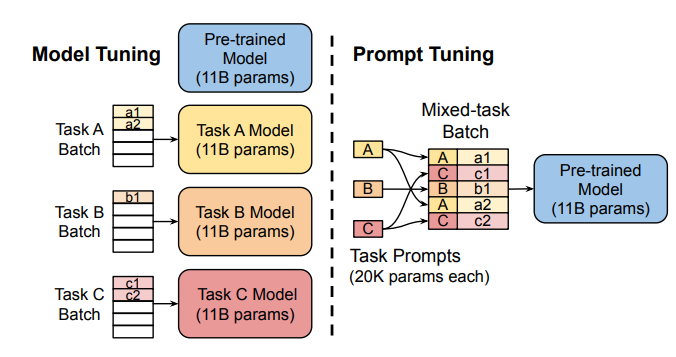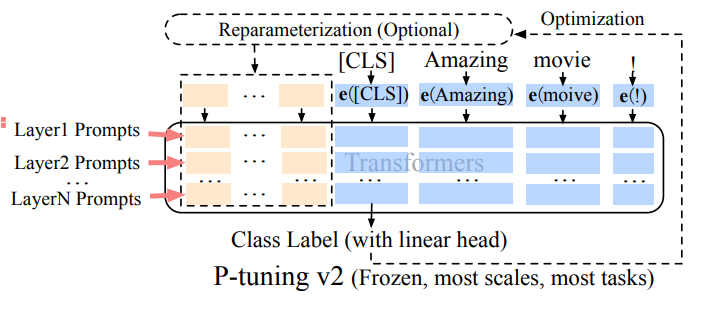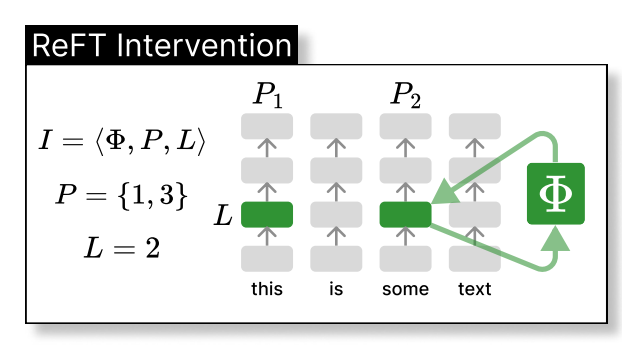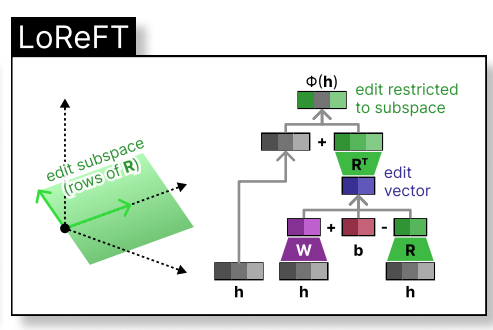Is ReFT All We Needed?
ReFT: A Revolutionary Approach to Fine-tuning LLMs
ReFT (Representation Finetuning), introduced in Stanford's May 2024 paper, offers a groundbreaking method for efficiently fine-tuning large language models (LLMs). Its potential was immediately apparent, further highlighted by Oxen.ai's July 2024 experiment fine-tuning Llama3 (8B) on a single Nvidia A10 GPU in just 14 minutes.
Unlike existing Parameter-Efficient Fine-Tuning (PEFT) methods like LoRA, which modify model weights or input, ReFT leverages the Distributed Interchange Intervention (DII) method. DII projects embeddings into a lower-dimensional subspace, enabling fine-tuning through this subspace.
This article first reviews popular PEFT algorithms (LoRA, Prompt Tuning, Prefix Tuning), then explains DII, before delving into ReFT and its experimental results.

Parameter-Efficient Fine-Tuning (PEFT) Techniques
Hugging Face provides a comprehensive overview of PEFT techniques. Let's briefly summarize key methods:
LoRA (Low-Rank Adaptation): Introduced in 2021, LoRA's simplicity and generalizability have made it a leading technique for fine-tuning LLMs and diffusion models. Instead of adjusting all layer weights, LoRA adds low-rank matrices, significantly reducing trainable parameters (often less than 0.3%), accelerating training and minimizing GPU memory usage.

Prompt Tuning: This method uses "soft prompts"—learnable task-specific embeddings—as prefixes, enabling efficient multi-task prediction without duplicating the model for each task.

Prefix Tuning (P-Tuning v2): Addressing limitations of prompt tuning at scale, Prefix Tuning adds trainable prompt embeddings to various layers, allowing task-specific learning at different levels.

LoRA's robustness and efficiency make it the most widely used PEFT method for LLMs. A detailed empirical comparison can be found in this paper.
Distributed Interchange Intervention (DII)
DII is rooted in causal abstraction, a framework using intervention between a high-level (causal) model and a low-level (neural network) model to assess alignment. DII projects both models into subspaces via orthogonal projections, creating an intervened model through rotation operations. A detailed visual example is available here.
The DII process can be mathematically represented as:

where R represents orthogonal projections, and the distributed alignment search (DAS) optimizes the subspace to maximize the probability of expected counterfactual outputs post-intervention.
ReFT – Representation Finetuning
ReFT intervenes in the model's hidden representation within a lower-dimensional space. The illustration below shows the intervention (phi) applied to layer L and position P:

LoReFT (Low-rank Linear Subspace Reft) introduces a learned projected source:

where h is the hidden representation, and Rs edits h in the low-dimensional space spanned by R. The LoReFT integration into a neural network layer is shown below:

During LLM fine-tuning, the LLM parameters remain frozen, and only the projection parameters (phi={R, W, b}) are trained.
Experimental Results
The original ReFT paper presents comparative experiments against full fine-tuning (FT), LoRA, and Prefix Tuning across various benchmarks. ReFT techniques consistently outperform existing methods, reducing parameters by at least 90% while achieving superior performance.

Discussion
ReFT's appeal stems from its superior performance with Llama-family models across diverse benchmarks and its grounding in causal abstraction, which aids model interpretability. ReFT demonstrates that a linear subspace distributed across neurons can effectively control numerous tasks, offering valuable insights into LLMs.
References
- Wu et al., ReFT: Representation Finetuning for Language Models
- Hu et al., LoRA: Low-Rank Adaptation of Large Language Models
- Zhuang et al., Time-Varying LoRA
- Liu et al., P-tuning v2
- Geiger et al., Finding alignments between interpretable causal variables and distributed neural representations
- Lester et al., The power of scale for parameter-efficient prompt tuning
- Pu et al., Empirical analysis of the strengths and weaknesses of Peft techniques for LLMs
(Note: Please replace the bracketed //m.sbmmt.com/link/6c11cb78b7bbb5c22d5f5271b5494381 placeholders with the actual links to the research papers.)
The above is the detailed content of Is ReFT All We Needed?. For more information, please follow other related articles on the PHP Chinese website!

Hot AI Tools

Undress AI Tool
Undress images for free

Undresser.AI Undress
AI-powered app for creating realistic nude photos

AI Clothes Remover
Online AI tool for removing clothes from photos.

Clothoff.io
AI clothes remover

Video Face Swap
Swap faces in any video effortlessly with our completely free AI face swap tool!

Hot Article

Hot Tools

Notepad++7.3.1
Easy-to-use and free code editor

SublimeText3 Chinese version
Chinese version, very easy to use

Zend Studio 13.0.1
Powerful PHP integrated development environment

Dreamweaver CS6
Visual web development tools

SublimeText3 Mac version
God-level code editing software (SublimeText3)

Hot Topics
 1797
1797
 16
16
 1750
1750
 56
56
 1594
1594
 29
29
 1475
1475
 72
72
 267
267
 587
587
 AI Investor Stuck At A Standstill? 3 Strategic Paths To Buy, Build, Or Partner With AI Vendors
Jul 02, 2025 am 11:13 AM
AI Investor Stuck At A Standstill? 3 Strategic Paths To Buy, Build, Or Partner With AI Vendors
Jul 02, 2025 am 11:13 AM
Investing is booming, but capital alone isn’t enough. With valuations rising and distinctiveness fading, investors in AI-focused venture funds must make a key decision: Buy, build, or partner to gain an edge? Here’s how to evaluate each option—and pr
 AGI And AI Superintelligence Are Going To Sharply Hit The Human Ceiling Assumption Barrier
Jul 04, 2025 am 11:10 AM
AGI And AI Superintelligence Are Going To Sharply Hit The Human Ceiling Assumption Barrier
Jul 04, 2025 am 11:10 AM
Let’s talk about it. This analysis of an innovative AI breakthrough is part of my ongoing Forbes column coverage on the latest in AI, including identifying and explaining various impactful AI complexities (see the link here). Heading Toward AGI And
 Kimi K2: The Most Powerful Open-Source Agentic Model
Jul 12, 2025 am 09:16 AM
Kimi K2: The Most Powerful Open-Source Agentic Model
Jul 12, 2025 am 09:16 AM
Remember the flood of open-source Chinese models that disrupted the GenAI industry earlier this year? While DeepSeek took most of the headlines, Kimi K1.5 was one of the prominent names in the list. And the model was quite cool.
 Future Forecasting A Massive Intelligence Explosion On The Path From AI To AGI
Jul 02, 2025 am 11:19 AM
Future Forecasting A Massive Intelligence Explosion On The Path From AI To AGI
Jul 02, 2025 am 11:19 AM
Let’s talk about it. This analysis of an innovative AI breakthrough is part of my ongoing Forbes column coverage on the latest in AI, including identifying and explaining various impactful AI complexities (see the link here). For those readers who h
 Grok 4 vs Claude 4: Which is Better?
Jul 12, 2025 am 09:37 AM
Grok 4 vs Claude 4: Which is Better?
Jul 12, 2025 am 09:37 AM
By mid-2025, the AI “arms race” is heating up, and xAI and Anthropic have both released their flagship models, Grok 4 and Claude 4. These two models are at opposite ends of the design philosophy and deployment platform, yet they
 Chain Of Thought For Reasoning Models Might Not Work Out Long-Term
Jul 02, 2025 am 11:18 AM
Chain Of Thought For Reasoning Models Might Not Work Out Long-Term
Jul 02, 2025 am 11:18 AM
For example, if you ask a model a question like: “what does (X) person do at (X) company?” you may see a reasoning chain that looks something like this, assuming the system knows how to retrieve the necessary information:Locating details about the co
 Batch Processing vs Mini-Batch Training in Deep Learning
Jun 30, 2025 am 09:46 AM
Batch Processing vs Mini-Batch Training in Deep Learning
Jun 30, 2025 am 09:46 AM
Deep learning has revolutionised the AI field by allowing machines to grasp more in-depth information within our data. Deep learning has been able to do this by replicating how our brain functions through the logic of neuron syna
 This Startup Built A Hospital In India To Test Its AI Software
Jul 02, 2025 am 11:14 AM
This Startup Built A Hospital In India To Test Its AI Software
Jul 02, 2025 am 11:14 AM
Clinical trials are an enormous bottleneck in drug development, and Kim and Reddy thought the AI-enabled software they’d been building at Pi Health could help do them faster and cheaper by expanding the pool of potentially eligible patients. But the





